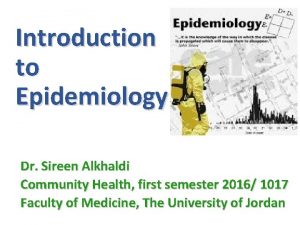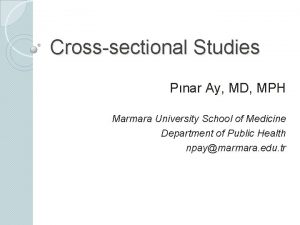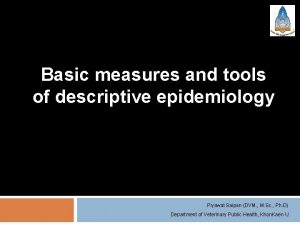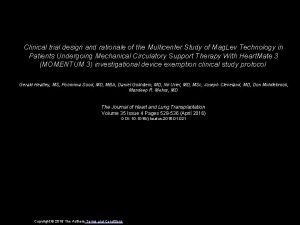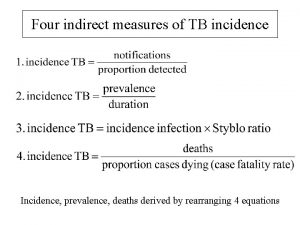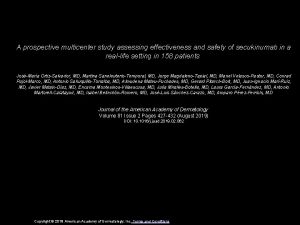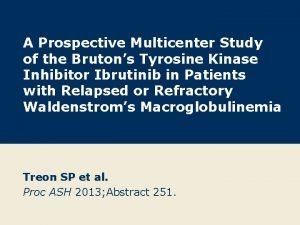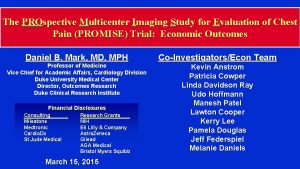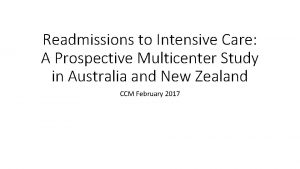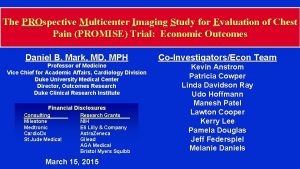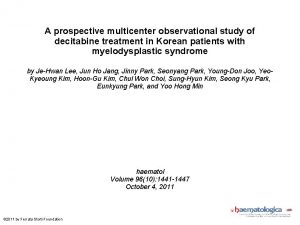Prospective multicenter study to assess point prevalence incidence











- Slides: 11


Prospective, multicenter study to assess point prevalence, incidence and recurrence of sexually transmitted infections in men who have sex with men in Germany (BRAHMS study) Hendrik Streeck Institute for HIV Research, Essen, Germany Institute for HIV Research @Hendrik. Streeck

Brahms Study Team -Acknowledgements We thank all volunteers for their participation in this study! Institut für HIV Forschung Hendrik Streeck Anna-Lena Brillen Alexandra Knorr Patrick Juszczak Alexandra Braselmann HPSTD Clinic, Essen Stefan Esser Robert Jablonka Institut für Interdisziplinäre Medizin (IFI) Albrecht Stoehr Andreas Plettenberg Thore Lorenzen Stefan Unger Infektiologikum Gabriele Knecht Markus Bickel Thomas Lutz Klinikum rechts der Isar Christoph Spinner Jochen Schneider Christiane Schwerdtfeger Marcel Lee Labor Krone Carsten Tiemann Dieter Münstermann Ann-Kathrin Ziesenis MHRP/WRAIR Universitätsklinikum Köln Universitätsklinikum Bonn Robert Gramzinski Merlin Robb Nelson Michael Sandyha Vasan Erica Broach Julie Dorsey Spitz Trevor Crowell Clara Lehmann Jörg-Janne Vehreschild Gerd Fäthkenheuer Florian Klein Praxis Hohenstaufenring Stefan Scholten Stephan Schneeweiß Mascha Mues Irene Beckmann Johannes Kühn Praxis Jessen 2+Kollegen Heiko Jessen Arne Jessen Praxis Dr. Cordes Christiane Cordes Martin Viehweger Elena Rodriguez Castellano Christian Lieb Robert Koch Institut Viviane Bremer Barbara Gunsenheimer-Bartmeyer Klaus Jansen Ulrich Marcus USAMMDA Elisabeth Heger Walk In Ruhr Norbert H. Brockmeyer Anja Potthoff Janet Wach ZIBP Berlin Christoph Boesecke Jürgen Rockstroh Community Advisory Board Armin Schafberger Dirk Sander Harriet Langanke Nicholas Feustel Christopher Knoll Marc Grenz Martin Ocepek Arne Kayser Christoph Claes Carsten Gehrig Jukka Hartikainen Axel Baumgarten This study was funded by:

Disclosur e Received project funds, grant awards or other kind of research related contributions in the last 5 years: Janssen, Gilead, Hologic, DFG, DZIF, BMG, ERC, EKFS, Hector, USAMMDA, NIH, Do. D. Received honorarium, consultancy fees, advisory fees or other kind of personal contributions in the last 5 years: BMS, Gilead, Janssen, Vii. V, MSD, Hexal, EMA.

* 1000 (18 -55) 1 HIV- 0 months 3 months 6 months 9 months 12 months 2 3 condomless anal intercourse with at least two unique male partners in the past 24 weeks documented history of Syphilis, rectal Mycoplasma genitalium, Chlamydia, Gonorrhea or acute Hepatitis C infection in the last 24 weeks • Anal swab • Pharyngeal swab • urine • blood * Assigned at birth, chosen or intersexual


High point prevalence of STIs at screening n=1040

Rectal and Asymptomatic

38% 17% 44%

STIs and Pr. EP use at baseline

Summar y • High point prevalence of STIs (Gonorrhea (9. 9%), Chlamydia trachomatis (12. 7%) and Mycoplasm genitalium (18. 8%)) low point prevalence of HIV (0. 4%) in individuals at risk for HIV infection. • High frequency of asymptomatic (in particular rectal) STIs. • There was no difference in STIs among Pr. EP users and Non-Pr. EP user at baseline. However, only the results of the incidence data will show whethere is a difference between both groups.
 Period prevalence vs point prevalence
Period prevalence vs point prevalence Period prevalence vs point prevalence
Period prevalence vs point prevalence Period prevalence vs point prevalence
Period prevalence vs point prevalence Period prevalence vs point prevalence
Period prevalence vs point prevalence Multicenter study design
Multicenter study design What is incidence
What is incidence Epirates
Epirates Descriptive vs analytical epidemiology
Descriptive vs analytical epidemiology Incidence vs incidence rate
Incidence vs incidence rate Retrospective cohort study vs prospective cohort study
Retrospective cohort study vs prospective cohort study Types of longitudinal studies
Types of longitudinal studies Longitudinal research design example
Longitudinal research design example
